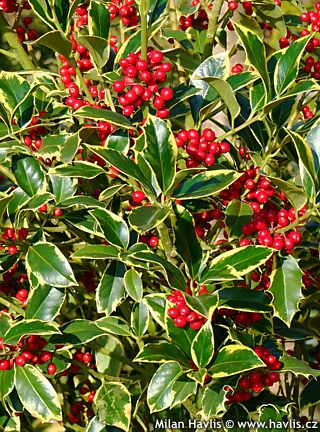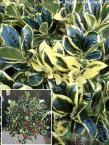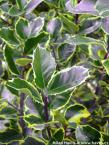Ilex aquifolium 'PYRAMIDALIS AUREOMARGINATA'

Ilex aquifolium 'PYRAMIDALIS AUREOMARGINATA'
English holly - female/self-fertile
English holly - female/self-fertile
| SIZE/TYPE | taller shrub |
|---|---|
| USUAL HEIGHT | 2-4m |
| USUAL WIDTH | 2-3m |
| LEAVES | evergreen broadleaf |
| COLOUR OF LEAVES |
  varigated:green and yellow varigated:green and yellow |
| LOCATION | full to partial sun |
| SOIL TYPE | acidic (peaty) |
| SOIL MOISTURE REQUIREMENTS | evenly moist (dislikes drought) |
| USDA zone (lowest) | 5b (down to -27°C) |
| WINTER PROTECTION | |
| FOR ZONE 5+6 |

|
| FOR ZONE 7 |

|
| BELONGS TO CATEGORIES |
Evergreen broadleaf Hedging plants |
Pyramidalis Aureomarginata is an attractive variegated sport of Pyramidalis holly. It produces highly glossy, evergreen leaves with deep green centres and thick yellow margins. They are spiny when the plant is young but change to almost entire (spineless) on older and taller plants which do not need to protect themselves from animals eating them.
In autumn the plant produces a heavy load of bright red, glossy berries. They are not edible nor poisonous but contain saponins which cause severe discomfort if eaten. Pyramidalis Aureomarginata is a female variety but self-fertile and needs no pollinator to produce them. On the other hand it offers plenty of pollen for other female hollies around.
It grows rather slowly (15-25 cm per year) into a narrowly conical to almost columnar shape in a dense habit which does not need pruning for symmetry. Hollies are often pruned. It is common to cut some branches in December as a Christmas decoration, and to achieve denser or smaller plants they can be pruned in early spring after all frosts. Early summer trimming is also possible, it will help the plants maintain its neat shape.
Grow hollies in moist but well-drained, fertile soil. They can take periods of drought once established but dislike compacted, heavy-clay-based soils that turn very dry in summer, and often too wet in winter. If your soil is such, dig the planting hole only half the depth of the root ball, refine what you dig out and mix it well with quality substrate of highly acidic level (low pH value). Using this mixture make a gradual slope from the stem to the original ground level and tamp it down as much as you can. Your root ball should not look like a molehill but more like a wide and flat mound. Mulch it well and keep watering it more often as it will be more prone to drying out as opposed to most common flat-in-the-ground transplanting.
Hollies do best in full sun but can also grow in shade where they will lose their compact habit. This variety proved very hardy even in full sun in winter. However, if you live in a region with cold winters and long-lasting frost we recommend growing it in position sheltered from drying winds, and preferably shaded from winter sun. Before and during winter when the soil is not frozen provide good watering. Hardy to about -27°C (USDA zone 5b).
Last update 18-02-2021
SIZES and PRICES
CURRENTLY SOLD OUT
GLOSSARY
|












